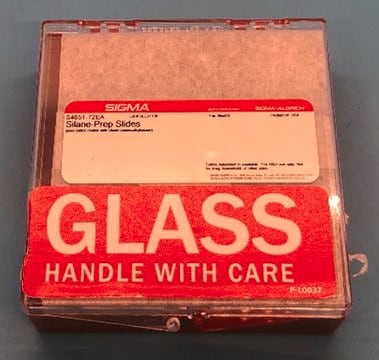This product has been cited as being a better tissue adhesive than poly-L-lysine. Maddox PH, Jenkins D., 3-Aminopropyltriethoxysilane (APES): a new advance in section adhesion. J Clin Pathol., 40(10):1256-7 (1987).
A3648
(3-aminopropyl)triéthoxysilane
≥98%
Synonyme(s) :
3-triéthoxysilylpropylamine, APTES, APTS
About This Item
Produits recommandés
Niveau de qualité
Essai
≥98%
Forme
liquid
pH
11 (20 °C, 20 g/L)
pb
217 °C/760 mmHg (lit.)
Pf
220-222 °C
Densité
0.946 g/mL at 25 °C (lit.)
Application(s)
diagnostic assay manufacturing
hematology
histology
Température de stockage
room temp
Chaîne SMILES
CCO[Si](CCCN)(OCC)OCC
InChI
1S/C9H23NO3Si/c1-4-11-14(12-5-2,13-6-3)9-7-8-10/h4-10H2,1-3H3
Clé InChI
WYTZZXDRDKSJID-UHFFFAOYSA-N
Vous recherchez des produits similaires ? Visite Guide de comparaison des produits
Application
Actions biochimiques/physiologiques
Mention d'avertissement
Danger
Mentions de danger
Conseils de prudence
Classification des risques
Acute Tox. 4 Oral - Eye Dam. 1 - Skin Corr. 1B - Skin Sens. 1
Code de la classe de stockage
8A - Combustible corrosive hazardous materials
Classe de danger pour l'eau (WGK)
WGK 1
Point d'éclair (°F)
199.4 °F - closed cup
Point d'éclair (°C)
93 °C - closed cup
Équipement de protection individuelle
Faceshields, Gloves, Goggles, type ABEK (EN14387) respirator filter
Faites votre choix parmi les versions les plus récentes :
Déjà en possession de ce produit ?
Retrouvez la documentation relative aux produits que vous avez récemment achetés dans la Bibliothèque de documents.
Les clients ont également consulté
-
How does Product A3648, (3-Aminopropyl)triethoxysilane, compare to poly-L-lysine for binding tissue to glass surfaces?
1 answer-
Helpful?
-
-
Can the coating made from product A3648, (3-Aminopropyl)triethoxysilane, be removed?
1 answer-
For Product A3648, (3-Aminopropyl)triethoxysilane, the siliconized coating can be removed by an overnight treatment with 10-20% (w/v) aqueous or alcoholic potassium hydroxide or sodium hydroxide solutions. It may also be possible to remove the coating by physical abrasion, i.e., scrubbing or vigorously brushing the glass surface. Autoclaving will not destroy the coating.
Helpful?
-
-
What is the concentration of the (3-Aminopropyl)triethoxysilane, commonly known as APTES?
1 answer-
The (3-Aminopropyl)triethoxysilane, which is a neat liquid, is 4.3 M. This is based on a density of 0.946 g/mL and a molecular weight of 221.37.
Helpful?
-
-
What is the Department of Transportation shipping information for this product?
1 answer-
Transportation information can be found in Section 14 of the product's (M)SDS.To access the shipping information for this material, use the link on the product detail page for the product.
Helpful?
-
-
Can I buy glass slides already treated with Product A3648, (3-Aminopropyl)triethoxysilane?
1 answer-
Yes. Silane Prep slides, Product No. S4651, are produced using A3648. These slides have an expiration period of 24 months.
Helpful?
-
-
Can Product A3648, (3-Aminopropyl)triethoxysilane, be used to coat controlled pore glass?
1 answer-
To coat controlled-pore glass beads for affinity chromatography, the following method is recommended:1. Treat 1 g of clean beads with 20 mL of a 10% aqueous A3648 (pH 3 to 4) at 75 °C for 2 hours.2. Filter the beads to remove the solution and dry overnight in a 115 °C oven. See: J. Dairy Sci., 73, 2720-2730 (1990).
Helpful?
-
Active Filters
Notre équipe de scientifiques dispose d'une expérience dans tous les secteurs de la recherche, notamment en sciences de la vie, science des matériaux, synthèse chimique, chromatographie, analyse et dans de nombreux autres domaines..
Contacter notre Service technique








![N-[3-(Trimethoxysilyl)propyl]ethylenediamine 97%](/deepweb/assets/sigmaaldrich/product/structures/149/508/f87a9a89-f138-4c5e-9fe0-6561914241c3/640/f87a9a89-f138-4c5e-9fe0-6561914241c3.png)




